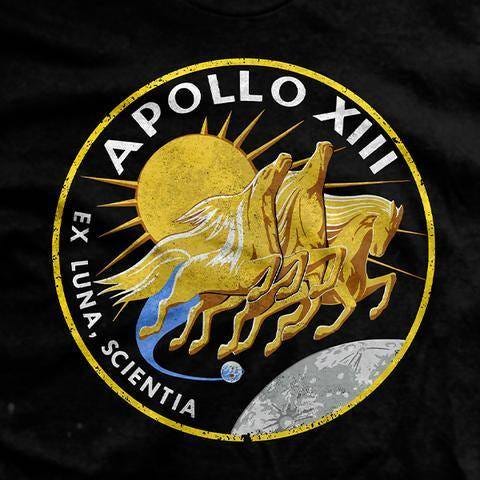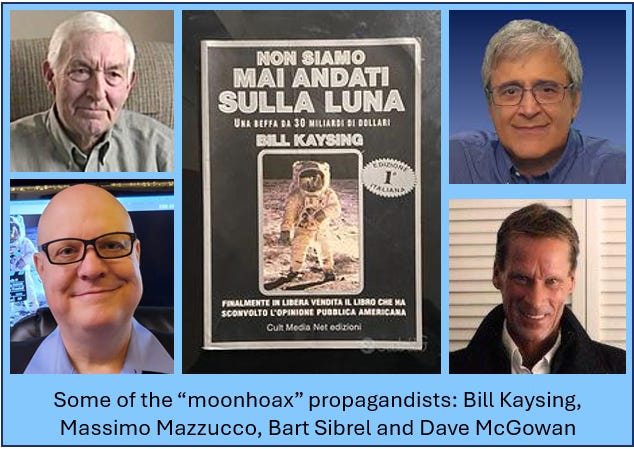"Houston, we have a problem." Was it scripted?
Diehard believer of the moon landings allows Apollo 13 mission was probably a "live" exercise.
… and some people thought the accident was a stunt just to get interest back again but, of course, it wasn’t.
Keith Wright, Systems Engineer - ALSEP Launch Operations, NASA Apollo Mission
From documentary, The Unbelievable True Story of the Apollo 13 Rescue
But the American public does not share NASA’s enthusiasm for the next Apollo mission. With the Vietnam war raging on and US ground troops having faced fierce combat for over five years, public interest in the moon is fading fast. People believe Apollo 13 will just be another routine flight.
“Public interest in the Apollo program reached a height in July 1969 when Neil Armstrong and Buzz Aldrin landed on the moon but it rapidly decayed after that. There was some press coverage of Apollo 12 but by the time Apollo 13 flew very little interest was shown. In fact, it was said that the TV companies were inundated with complaints from members of the public that their favourite programs were going to be bumped off schedule to cover Apollo 13.”
Dr Nigel Bannister, Dept. Physics & Astronomy, University of Leicester“It’s interesting how quickly the public got a bit bored with it all because it all just seemed to go like clockwork, didn’t it?, and people had got completely fed up with seeing the crew weightless and just poking at bits of equipment that nobody could understand.”
Professor Mike Cruise, Dept. Physics & Astronomy, University of Birmingham“I think one of the problems there was that NASA was not emphasizing the science that was going on and the knowledge that was coming back so interest was waning until the accident and some people thought the accident was a stunt just to get interest back again but, of course, it wasn’t.”
Keith Wright, Systems Engineer - ALSEP Launch Operations, NASA Apollo Mission
I have been busy making myself unpopular by insisting that the moon landings really happened, however, courtesy of comments on Apollo 13 from
(very indebted to you, Evelyn!) on my last post, Good and Bad Modal Thinking, I’ve been forced into a slight re-think. My view hasn’t changed on their reality, however, in the case of Apollo 13 - which didn’t land - I believe it’s quite probable that the flight was really an exercise in emergency response rather than a real-life emergency situation.The facts that suggest an exercise
Coincidental numbers
Mission number: 13
Launch time: 13:13.
(I was confused by interviewers discussing this coincidence because what you get when you look up launch time is 14:13, however, the later time is Florida time (EST) while 13:13 was the time in Mission Control, Houston (CST)).Explosion date: April 13.
Explosion time into mission: 55:54:53.
Coincidental names
Prior to the mission, the Command Module was assigned the call sign, Odyssey, while the Lunar Module was assigned the call sign, Aquarius.
Command Module - Odyssey
In his book, Lost Moon: The Perilous Voyage of Apollo 13, the Commander, Jim Lovell, indicated he chose the name Odyssey because he liked the word and its definition: a long voyage with many changes of fortune. It is also interesting to consider that Odysseus - from whom the term derives - was the mastermind behind the cunning Trojan Horse plan.
Lunar Module - Aquarius
Wikipedia tells us - emphasis added:
The Apollo 13 mission insignia depicts the Greek god of the Sun, Apollo, with three horses pulling his chariot across the face of the Moon, and the Earth seen in the distance. This is meant to symbolize the Apollo flights bringing the light of knowledge to all people. The mission motto, Ex luna, scientia ("From the Moon, knowledge"), appears. In choosing it, Lovell adapted the motto of his alma mater, the Naval Academy, Ex scientia, tridens ("From knowledge, sea power").
So while we are told that Jim was inspired indirectly by the Naval Academy’s motto to come up with “Aquarius” as the LM’s call sign, it is rather coincidental that water issues featured prominently after the alleged explosion:
supposedly the cabin was covered in moisture
however, despite the wet cabin, potable water needed to be rationed to the point that the Lunar Module pilot, Fred Haise, developed a urinary tract infection
One is reminded of the Rime of the Ancient Mariner: “Water, water everywhere … nor any drop to drink.”
Other implausibilities / oddities / coincidences
Marilyn Lovell’s wedding ring
There's also a scene in that movie where Marilyn Lovell's (Tom Hanks' character's wife) wedding ring falls down the shower drain the morning of the launch. A few test audience members said that it was a bit over-dramatic.
But the real Marilyn Lovell really DID drop her wedding ring down the shower drain the morning of the launch.
Did she now? In an interview she said she hoped it wasn’t a bad omen.
But don’t worry, it was recovered.
The iconic “Houston, we have a problem” is a misquote, it’s “… we’ve had … “
The actual transcript is as follows:
55:54:52 – Jack Swigert (Apollo 13): “Okay, Houston, we've had a problem here.”
55:54:55 – Jack Lousma (CapCom): “This is Houston. Say again, please.”
55:54:57 –Jim Lovell (Apollo 13): “Houston, we've had a problem. We've had a main B bus undervolt.”
55:55:05 – Lousma (CapCom): “Roger. Main B undervolt.”
55:55:29 – Lovell: “And we had a pretty large bang associated with the caution and warning there.”
55:55:34 – Fred Haise: “And as I recall, main B was the one that had an amp spike on it once before.”
55:55:38 – Lovell: “Roger, Fred.”
Why would the line that became iconic be a misquote one wonders.
Song, Willow weep for me
10 mins before the explosion the song, Willow weep for me plays.
The willow is a highly symbolic tree that has associations with water, transformation and resilience.
Jim Lovell’s experience on Apollo 8 using the sun for navigation came in very handy
One of Jim’s major tasks on Apollo 8 was verifying spacecraft orientation and position using celestial navigation—sighting stars, the Moon, and the Sun through the spacecraft’s sextant and optical equipment. This was critical because Apollo 8 was the first mission to leave Earth orbit and head to the Moon, so ensuring accurate navigation with limited ground support was essential.
In one famous maneuver, while Fred Haise and Jack Swigert controlled the spacecraft, Lovell looked out the window to make sure the Sun stayed fixed in a specific position relative to the spacecraft’s crosshairs. If the Sun moved, it meant they were rotating off course, so they adjusted accordingly.
Jack Swigert’s involvement in writing the Command Module systems manual also came in very handy
Swigert joined the Apollo 13 crew only three days before launch, after original CM pilot Ken Mattingly was grounded due to exposure to German measles. (It’s interesting that we see “measles” in some places “German measles” in others for the grounding of original crew members.)
After the oxygen tank explosion crippled the Service Module, the crew had to rely heavily on the Command Module systems during the final phase of the mission, particularly during re-entry. Swigert's intimate understanding of those systems helped ensure the spacecraft could be powered up safely after being powered down to save energy. The power-up sequence was complex, with very little margin for error, and Swigert’s expertise was a reassuring asset in those tense final hours.
Making cylindrical CO2 scrubbers work with rectangular scrubbers using cardboard, duct tape, plastic bags, space-suit hoses and an old sock?
Due to the problem with the Service Module the three astronauts had to travel a great deal of their journey in the Lunar Module which was only intended for use as a shuttle between the spacecraft and the moon thus only to hold two astronauts for a relatively short time. While travelling, the CO2 breathed out by the astronauts needed to be removed. Supposedly, there was an engineering goof that had the CO2 scrubbers in the LM rectangular while those in the CM were cylindrical and a solution was needed to make the CM scrubbers work with the LM scrubbers. The solution arrived at involved using cardboard, duct tape, plastic bags, space-suit hoses and - according to Jim Lovell in this interview - an old sock, however, while we see in the transcript that the use of either a piece of sock or wet wipe is suggested to stop up a bypass hole, neither is shown in any of the diagrams presented. Moreover, we would not expect old socks aboard Apollo 13.
Fred Haise pranks by flipping valve making a loud bang … and then there’s the real one
We are told that Fred Haise would flip the lunar module’s cabin-repressurization valve, which made a fairly loud bang as it activated, as a prank.
Astronaut Recalls the Peril of Apollo 13 and Joys of a Test Pilot’s Life
Lovell’s initial thought on hearing the noise was that Haise had once again activated the lunar module’s cabin-repressurization valve, but he could see that Haise had no idea what had happened.
The motif of the pre-pretend-event followed by the supposed real event (but in actuality also pretend) is very common in staged events and I wonder how credible it is that Fred would flip the cabin-repressurization valve, especially on a reasonably regular basis and on his first space flight.
Different versions that contradict and contain seeming falsity (emphasis added)
In this article it says:
Haise was still in the tunnel between the command and lunar modules putting away items he’d used to illustrate weightlessness and other aspects of an astronaut’s life in space [for the TV broadcast that finished a few minutes prior to the explosion - another coincidence?]
however, at 20:47 in this documentary, Jim Lovell says:
Fred [Haise] was still in the lunar module, Jack was back in the command module in the left-hand seat and I was half-way in between in the lower equipment bay wrestling with TV wires and a camera.
ChatGPT just keeps changing its mind about where the two guys were!
ChatGPT tells us that the lower equipment bay was in the “lower section of the CM interior, beneath the crew seating area, and it played a crucial role in housing critical equipment and storage.” ChatGPT also tells us that Jack Swigert often worked in the Lower Equipment Bay while Jim Lovell moved around for observations, system checks, and navigation.
Conclusion
I think they went around the moon as claimed but didn’t suffer an explosion and the mission was, in reality, a “live” exercise. While no doubt performing a “live” emergency exercise had significant benefit perhaps this “live” exercise would never have occurred if not for the waning public interest in the Apollo program indicated in the quote at the top.
Any contributions by readers welcome.
References
Related








Each psyop needs heroes, Apollo 13 is just like the "Let's Roll!" guys on UA 93 on 9.11. This makes the fakery more realistic, and helps to vilify truthers/deniers as not being respectful of the heroes.
They tried to make Trump and Musk heroes but that's not going so well.
Posting my favorite video about the Apollo 13 fraud--it covers a lot of the main points in about 20 minutes, including the dispute about heat versus cold, information about the physical construction of the LM, and the plausibility of survival, which would have been zero. https://www.youtube.com/watch?v=3di6odvdNZk&list=PLmgH9CC5ZMHNbV5TzfnpkUvaA-MyjiTNn&index=5